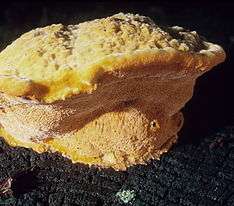Hapalopilus croceus
| Hapalopilus croceus | |
|---|---|
 | |
| Scientific classification | |
| Kingdom: | Fungi |
| Division: | Basidiomycota |
| Class: | Agaricomycetes |
| Order: | Polyporales |
| Family: | Polyporaceae |
| Genus: | Hapalopilus |
| Species: | H. croceus |
| Binomial name | |
| Hapalopilus croceus (Pers.) Donk (1933) | |
| Synonyms[1] | |
| |
Hapalopilus croceus is a species of polypore fungus. It was originally described by Christian Hendrik Persoon in 1796 as Boletus croceus; Marinus Anton Donk transferred it to genus Hapalopilus in 1933 to give it the name by which it is currently known. The species is found in Asia, Europe, Oceania, and North America, where it grows on the rotting wood of deciduous trees.[3]
References
- ↑ "Hapalopilus croceus (Pers.) Donk". Species Fungorum. CAB International. Retrieved 2014-07-03.
- ↑ Lowe JL. (1975). "Polyporaceae of North America. The genus Tyromyces". Mycotaxon. 2 (1): 1–82 (see p. 21).
- ↑ Zhishu B, Zheng G, Taihui L (1993). The Macrofungus Flora of China's Guangdong Province. New York, New York: Columbia University Press. p. 199.
External links
This article is issued from Wikipedia - version of the 10/29/2016. The text is available under the Creative Commons Attribution/Share Alike but additional terms may apply for the media files.